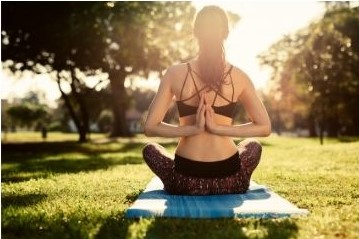Viparita Namaskarasana – Reverse Prayer Pose, How To Do, Benefits
By Dr Raghuram Y.S. MD (Ay) & Dr Manasa, B.A.M.S
Namaskara is another name of Namaste. It is the Indian way of salutation or offering prayer in which both hands are brought in opposition to each other in front of the chest. In Viparita Namaskarasana the hands come together to form a Namaste not in front of your body but at the back.
It is also called as Paschima Namaskarasana. Paschima means back, being behind or posterior.
Viparita = Reverse
Namaskara = Hand fold in form of Indian way of salutation
Asana = Pose
It is translated into ‘Reverse Prayer Pose’. It is also called as ‘Penguin Pose’ or ‘Hands behind the back prayer pose’. It is also a variation of Tadasana. It is an upper body pose. It helps strengthen arms, shoulders and abdomen.
Read – Surya Namaskar – Sun Salutation, Meaning, How To Do, Benefits

Table of Contents
Preparation for Viparita Namaskarasana
- The Reverse Prayer Pose should be done early morning for empty stomach. If it is practiced in the evening or some other time you should take food 3-4 hours before doing the pose. This will ensure that you are empty stomach by the time you take on to the pose and the food that you have consumed will also keep you energized to take on to the pose.
- Keep bowel and bladder empty while doing the pose.
Method of doing
Positioning for the Asana
- Stand straight on the floor or yoga mat.
- See that legs are together with feet kept about 1 inch apart
- Relax shoulders. Hands hanging freely by the sides of the body. Now you are in Tadasana or Mountain Pose.
Performing the Pose
- Begin relaxing shoulders while bending knees a bit.
- Take arms behind your back and start raising them along the midline of the back.
- Proceed to join palms. Keep the fingers pointing downwards.
- Inhale.
- Turn finger tips inward towards the spine such that the finger tips of both hands are in close opposition.
- Rotate fingers until palms are joined as you turn fingertips upwards. Palms are pressed firmly against each other and so are the corresponding fingertips facing upwards.
- Try to raise hands and place them joined together in between the shoulder blades if possible.
- Be here for 25-30 seconds. Close eyes and relax as if you are praying.
Release from the pose
- Separate the palms.
- Start turning fingertips downwards.
- Release hands and bring them back to the sides.
- Now you are standing back in Tadasana.
- Breathe slowly and relax.
- Take a break of 60 seconds and repeat the pose.
Read – Ashtanga Namaskara – Eight Limbed Pose, How To Do, Benefits
Related Video
Watch this video to follow the method of doing Ardha Baddha Padma Paschimottanasana
https://www.youtube.com/watch?v=KFIJcEs_F2E
Variations
Reverse prayer pose can also be done from seated pose. It can be done Sukhasana i.e. Easy Pose It can also be done from Padmasana i.e. Lotus Pose.
Modifications
Initially if you cannot get the palms or fingers together at your back due to lack of flexibility you may be slow on the process. Initially you may stop at whatever level your flexibility allows you to climb hand up the spine. Initially it is good even if you can get fingertips together or if you bring hand together at lower back or lower middle back. With practice you may take hands higher.
Read – Ardha Padmasana – Half Lotus Pose, How To Do, Benefits, Dosha Effects
Health Benefits
- Releases the tension in shoulders and collarbones
- Massages shoulders and loosens tight shoulder muscles, relaxes shoulder blades
- Relieves shoulder and neck pain
- Strengthens shoulders, arms, abs and arm muscles
- Increases flexibility of forearms and wrists
- Stretches upper back, pectoral muscles and shoulder joints
- Strengthens wrist tendons
- Prevents tendonitis of hand and carpal tunnel syndrome
- Opens up chest and abdomen, allows deeper breaths
- Promotes digestion, helps maintain metabolism
- Keeps you energized
- Prevents wrist damages and strain. It is specially useful for those who put their wrist too much into usage.
- Alleviates stress, calms mind
Time spent in doing Viparita Namaskarasana
One needs to be in this pose for at least 25-30 seconds. You can extend the time if you are comfortable and flexible to be there for more time.
Impact on Chakras
This pose opens up chest and heart chakra i.e. Anahata Chakra. This is associated with emotional stability, acceptance of self and others, love, compassion and forgiveness. These qualities are induced in the practitioner. One can experience self realization when this chakra is balanced.
Read – Chakra – Kundalini: Introduction, Meaning, Types, Location, Ayurveda View
Contraindications, Precautions
Patients suffering from below mentioned conditions should avoid doing Viparita Namaskarasana –
- Low Blood Pressure
- Arm injuries
- Shoulder injuries
- Neck injuries
Impact of on doshas and tissues
Impact on Doshas and its subtypes – Since this pose opens up your chest and aids easy breathing and also opens up the heart chakra it is good for balancing udana vata, sadhaka pitta, vyana vata and avalambaka kapha. The pose also helps in promoting digestion and balancing metabolism. Therefore it is beneficial for the balance of samana vata and pachaka pitta. Since it also alleviates stress and calms the mind it is good for balance of prana vata, sadhaka pitta and tarpaka kapha.
Impact on tissues – Reverse Prayer Pose strengthens and stretches your muscles and also improves flexibility. Therefore it has a good for health of muscles and muscle transporting channels. It is also good for bone tissue and related channels and also for the health of the joints.
Click to Consult Dr Raghuram Y.S. MD (Ayu)









